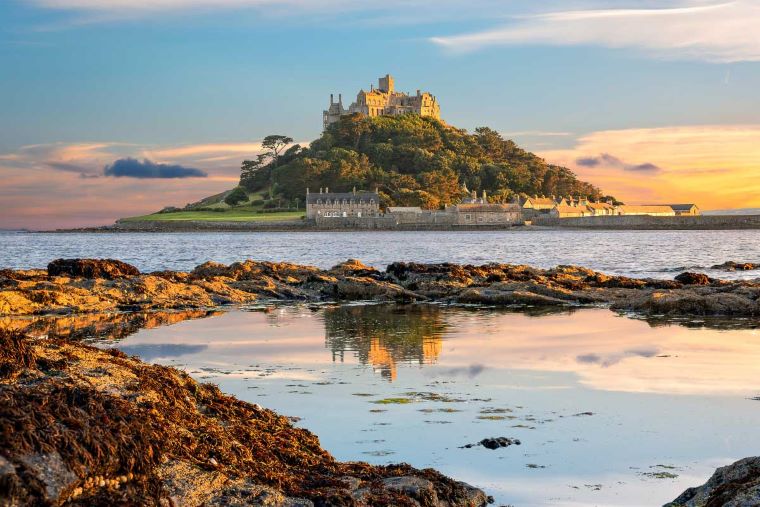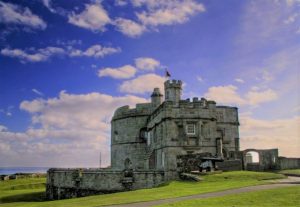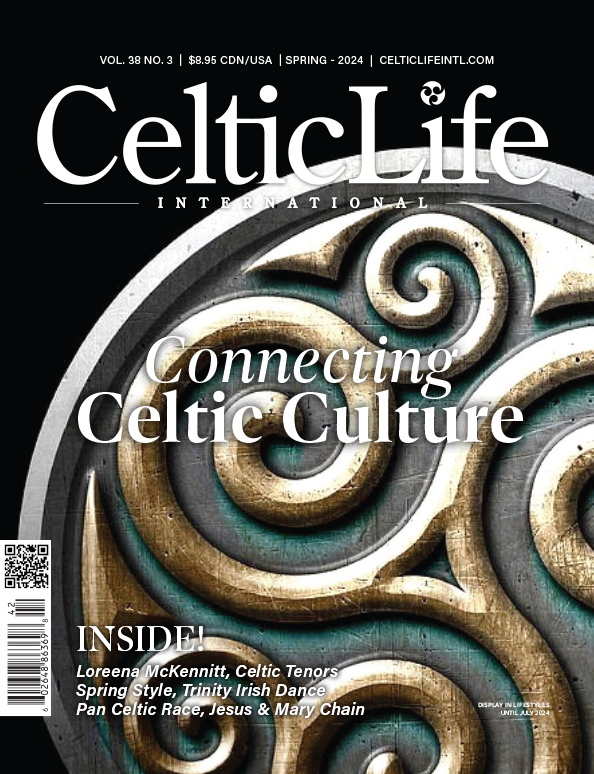
Cornwall is home to some truly dramatic scenery and a remarkable number of historic fortifications, many of which are wreathed in legend.
St Michael’s Mount
A towering spectacle and a sumptuous family home, St Michael’s Mount is a sea-bound castle on its own island, off the south coast of Cornwall. An important destination for pilgrims, it takes its name from a vision of St Michael said to have appeared at the summit in 495. Walking across the causeway at low tide to reach the castle is quite an adventure, but at high tide you’ll need to catch a boat across. Once there, explore the village that surrounds the castle and gaze back at the rugged Cornish coast.
Caerhays Castle
Part of the verdant Caerhays estate, Caerhays Castle is relatively junior compared to many castles in the region: here, construction began only 200 years ago. What it lacks in age however, it makes up for in looks, with white stone walls, towering ramparts and a picturesque rural setting. Caerhays treats visitors to a real jewel of an English castle, surrounded by lavish gardens of which tours are available.
Tintagel Castle
The secrets of Tintagel lie coiled among the rocks and rubble where this mighty cliff-top castle once stood. A rugged and romantic setting, Tintagel is said to be the birthplace of the fabled King Arthur. It would certainly be apt, as this is a dramatic site, perched high on the north Cornwall coast and overlooking the rocks and waves crashing below. Visitors can see Merlin’s Cave, learn about the myths and legends associated with the area and take in this iconic Cornish attraction.
Restormel Castle
The circular keep of this impressive 13th-century castle still stands today, and you can walk between the walls of its former rooms imagining what went on here during its lengthy history. Once the luxurious home of the Earls of Cornwall, this Norman keep fell to ruin after the English Civil War. Today it’s a stunning monument to Norman architecture, and an excellent vantage point to take in the surrounding countryside.
 Pendennis Castle
Pendennis Castle
Pendennis was one of Henry VIII’s primary defences against naval attack, and it was strengthened during the late 16th century in anticipation of invasion by the Spanish Armada. It played a key role in the English Civil War too, and was the second-to-last stronghold to fall to the Parliamentarians. It’s also offers excellent access to nearby Falmouth, as well as spectacular views over the town and harbour.
St Catherine’s Castle
St Catherine’s Castle was part of Henry VIII’s network of coastal fortifications, built to lend Fowey Harbour a little extra firepower and defend it against invasion. Entry to the castle today is free, and for visitors to Fowey it’s an excellent way to get at a commanding view of the countryside and surrounding area, thanks to the castle’s position high above the entrance to the Fowey estuary.
St Mawes Castle
One of the best preserved of Henry VIII’s chain of Cornish coastal artillery fortresses, St Mawes is also the flashiest, elaborately engraved with Latin inscriptions in praise of the King. It’s just across the Fal estuary from Pendennis Castle, so if you’re feeling adventurous, catch a boat across the water and visit both.
Launceston Castle
The site of Launceston Castle has played a part in history for 1,000 years, according to archaeological excavation on the site. But the main castle here was built by Richard, Earl of Cornwall in the 13th century, and was a prison for many years. Today visitors can ascend to the tower through the main keep by a dark staircase and learn about some of the keep’s former unlucky inhabitants.
Carn Brea Castle
Built in 1379 by the Bassett family, Carn Brea Castle has long been the site of a fort. Excavations revealed evidence of a Neolithic settlement here between 3700 and 3400 BC, and a hoard of Iron Age gold was discovered. It’s a great spot to learn a little history, and grab a bite to eat – Carn Brea Castle is today a restaurant, and offers excellent views over Redruth.
Prideaux Place
While not strictly a castle, this 400-year-old Elizabethan manor house has all the history of a renaissance military fortification, plus more. As the family home of ancient Cornish clan the Prideaux family for 14 generations, it’s accumulated a spectacular array of interesting objects to admire. Still inhabited today, it’s a great opportunity to see how styles have changed since 1592, moving through Elizabethan, Georgian and Victorian times, with a bit of colourful wartime history too.






















Leave a Comment